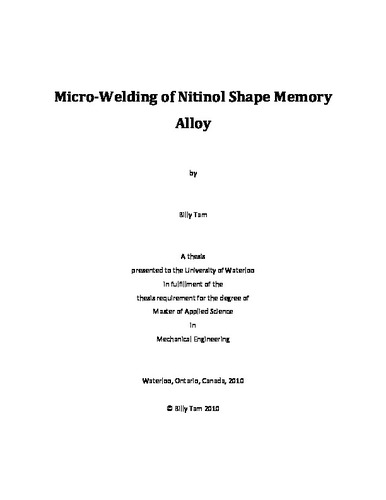| dc.description.abstract | Nitinol shape memory alloys have revolutionized many traditional engineering designs with the unique properties of pseudoelasticity and shape memory effect. At the present moment, primary fabrication processes for Nitinol-based devices include laser cutting and manual techniques. As the interest in incorporating Nitinol in different micro applications and devices increases, the development of effective technology for micro-welding of Nitinol becomes necessary. In general, welding processes may induce significant changes to the processed area rendering the component incompatible or unusable. Strength reduction, inclusions of intermetallic compounds, and changes in pseudoelastic and shape memory effects are all examples of how Nitinol can be affected by welding.
The current study has examined the effects of two welding techniques on Nitinol: micro-resistance spot welding (MRSW) and laser micro-welding (LMW). Ni-rich Nitinol wires were welded in a crossed-wire configuration at different energy inputs by varying welding currents for MRSW and peak powers for LMW. The characterization of weld properties focused on the mechanical properties and bonding mechanisms, weld microstructure and formation, and phase transformation temperatures. Additionally, the effects of surface oxide on joint performance were also examined.
During MRSW, the primary bonding mechanism was solid state, which consisted of 6 main stages: cold collapse, dynamic recrystallization, interfacial melting, squeeze out, excessive flash, and surface melting. Attempt was made to correlate the joining mechanism with the contact resistances. Joint strength and fracture mechanism were closely linked to the metallurgical properties of the welds. Finally, differential scanning calorimetry (DSC) tests showed that weld metal underwent phase transformation at lower temperatures compared to base material.
The second part of this study investigated the effects of Nd:YAG laser micro welding have on Nitinol wires. The fracture strength, weld microstructure, and phase transformation temperatures resulting from the use of varying peak power inputs were studied and compared to both base metal and welds produced using the MRSW process. Results showed good retention of base metal strength and pseudoelastic properties. Moreover, the fusion zone underwent phase transformation at higher temperatures compared to base metal, which substantially altered the active functional properties of Nitinol at room temperature. | en |

